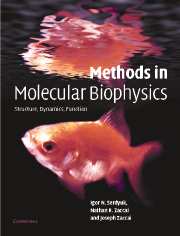Book contents
- Frontmatter
- Contents
- Foreword by D. M. Engelman
- Foreword by Pierre Joliot
- Preface
- Introduction: Molecular biophysics at the beginning of the twenty-first century: from ensemble measurements to single-molecule detection
- Part A Biological macromolecules and physical tools
- Part B Mass spectrometry
- Part C Thermodynamics
- Chapter C1 Thermodynamic stability and interactions
- Chapter C2 Differential scanning calorimetry
- Chapter C3 Isothermal titration calorimetry
- Chapter C4 Surface plasmon resonance and interferometry-based biosensors
- Part D Hydrodynamics
- Part E Optical spectroscopy
- Part F Optical microscopy
- Part G X-ray and neutron diffraction
- Part H Electron diffraction
- Part I Molecular dynamics
- Part J Nuclear magnetic resonance
- References
- Index of eminent scientists
- Subject Index
- References
Chapter C1 - Thermodynamic stability and interactions
from Part C - Thermodynamics
Published online by Cambridge University Press: 05 November 2012
- Frontmatter
- Contents
- Foreword by D. M. Engelman
- Foreword by Pierre Joliot
- Preface
- Introduction: Molecular biophysics at the beginning of the twenty-first century: from ensemble measurements to single-molecule detection
- Part A Biological macromolecules and physical tools
- Part B Mass spectrometry
- Part C Thermodynamics
- Chapter C1 Thermodynamic stability and interactions
- Chapter C2 Differential scanning calorimetry
- Chapter C3 Isothermal titration calorimetry
- Chapter C4 Surface plasmon resonance and interferometry-based biosensors
- Part D Hydrodynamics
- Part E Optical spectroscopy
- Part F Optical microscopy
- Part G X-ray and neutron diffraction
- Part H Electron diffraction
- Part I Molecular dynamics
- Part J Nuclear magnetic resonance
- References
- Index of eminent scientists
- Subject Index
- References
Summary
Historical overview and biological applications
The term thermodynamics is derived from the Greek therme meaning heat and dynamis meaning strength or force. Thermodynamics, as a science, has its beginnings in the nineteenth century, with the first experiments exploring the relationship between heat and work, the definitions of the concepts of temperature and energy and the clear enunciation of the first and second laws of thermodynamics. Classical thermodynamics uses a phenomenological approach based upon these laws, in contrast to statistical thermodynamics, which tries to establish a more fundamental understanding of heat in terms of the kinetics of large assemblies of atoms or molecules. The concept of work was generalised beyond mechanical work to include all forms of energy such as electric, magnetic, chemical, and radiation energy. The validity of thermodynamics was established for all types of system, from a volume of perfect gas at a given pressure to thermonuclear plasma, encompassing magnetic systems, liquid–vapour systems, macromolecular solutions, chemical reactions etc. In this chapter, we are concerned, in particular, with the applications of both classical and statistical equilibrium thermodynamics to biological macromolecules, their solutions and interactions.
Early in the seventeenth century, Galileo Galilei and his followers constructed the first thermometers, allowing reproducible measurements of temperature. Joseph Black (1728–1799) built the first calorimeter; he is considered the founder of calorimetry. His measurements led to the theory of caloric, a conserved elastic fluid that had weight and was associated with temperature. Antoine-Laurent Lavoisier (1780) performed the first calorimetric measurements in biology.
- Type
- Chapter
- Information
- Methods in Molecular BiophysicsStructure, Dynamics, Function, pp. 173 - 193Publisher: Cambridge University PressPrint publication year: 2007



